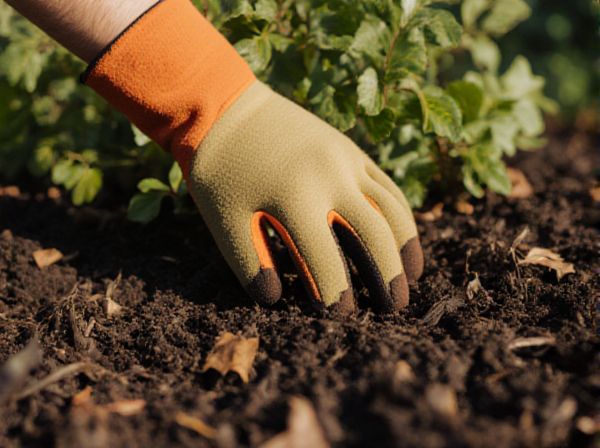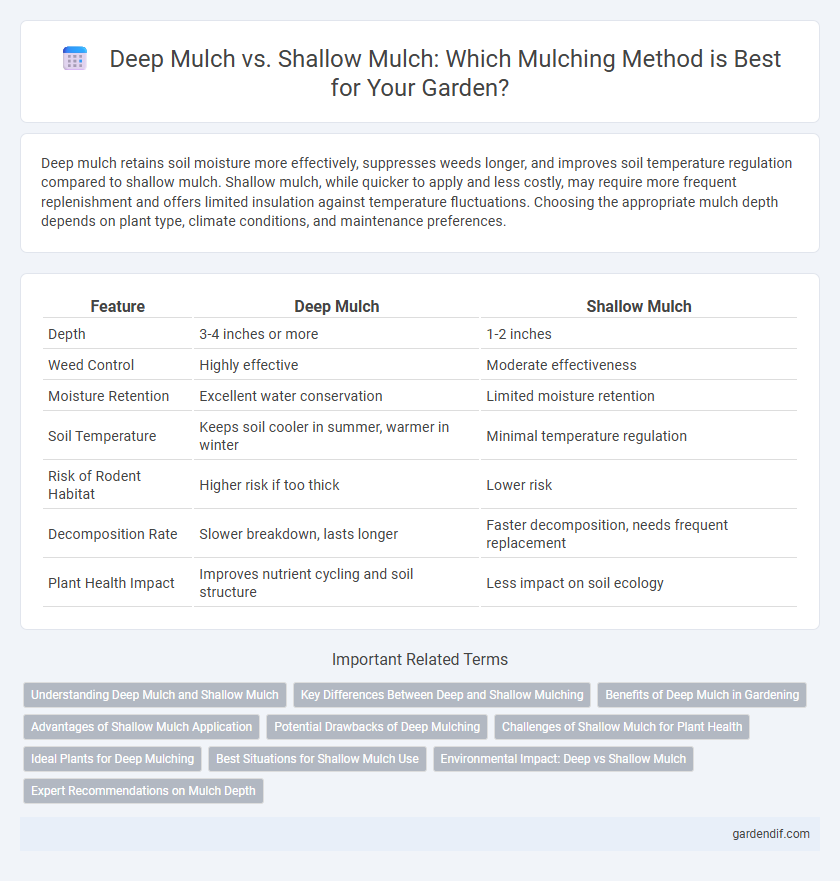
Deep mulch vs shallow mulch Illustration
Deep mulch retains soil moisture more effectively, suppresses weeds longer, and improves soil temperature regulation compared to shallow mulch. Shallow mulch, while quicker to apply and less costly, may require more frequent replenishment and offers limited insulation against temperature fluctuations. Choosing the appropriate mulch depth depends on plant type, climate conditions, and maintenance preferences.
Table of Comparison
| Feature | Deep Mulch | Shallow Mulch |
|---|---|---|
| Depth | 3-4 inches or more | 1-2 inches |
| Weed Control | Highly effective | Moderate effectiveness |
| Moisture Retention | Excellent water conservation | Limited moisture retention |
| Soil Temperature | Keeps soil cooler in summer, warmer in winter | Minimal temperature regulation |
| Risk of Rodent Habitat | Higher risk if too thick | Lower risk |
| Decomposition Rate | Slower breakdown, lasts longer | Faster decomposition, needs frequent replacement |
| Plant Health Impact | Improves nutrient cycling and soil structure | Less impact on soil ecology |
Understanding Deep Mulch and Shallow Mulch
Deep mulch, typically 3 to 6 inches thick, promotes moisture retention, suppresses weeds effectively, and improves soil structure by encouraging microbial activity. Shallow mulch, applied at 1 to 2 inches, offers quicker warming of the soil and reduces the risk of root rot but is less effective in long-term weed control and moisture conservation. Selecting the appropriate mulch depth depends on plant type, soil condition, and climate to optimize growth and health.
Key Differences Between Deep and Shallow Mulching
Deep mulch layers, typically exceeding 3 inches, provide superior moisture retention and weed suppression compared to shallow mulch layers of 1 to 2 inches. Shallow mulch enables quicker soil warming and better aeration but requires more frequent replenishing to maintain effectiveness. Choosing between deep and shallow mulch depends on plant type, climate, and specific garden needs for optimal growth and soil health.
Benefits of Deep Mulch in Gardening
Deep mulch enhances soil moisture retention by reducing evaporation, which supports consistent plant growth and reduces irrigation frequency. It suppresses weed growth more effectively than shallow mulch, decreasing competition for nutrients and improving garden health. The thicker layer also contributes to better soil temperature regulation, promoting microbial activity and nutrient cycling essential for robust plant development.
Advantages of Shallow Mulch Application
Shallow mulch application promotes better air circulation and prevents excessive moisture retention, reducing the risk of root rot and fungal diseases. It encourages deeper root growth by allowing soil to warm more quickly in the spring, enhancing nutrient uptake and plant vigor. Shallow mulch also conserves moisture while minimizing the habitat for pests like slugs and rodents, resulting in healthier garden ecosystems.
Potential Drawbacks of Deep Mulching
Deep mulching, typically exceeding 4 inches in thickness, can lead to potential drawbacks such as reduced soil aeration and water penetration, which may suffocate plant roots. Excessive mulch depth can also create a habitat for pests and promote fungal diseases by retaining too much moisture. Shallow mulch layers, usually 2 to 3 inches thick, avoid these issues by allowing better gas exchange and minimizing pest infestations while still conserving soil moisture.
Challenges of Shallow Mulch for Plant Health
Shallow mulch can lead to inadequate moisture retention and insufficient weed suppression, causing increased soil evaporation and root competition. It often fails to regulate soil temperature effectively, resulting in stress for plant roots during extreme weather conditions. These challenges contribute to weaker plant health and reduced growth compared to the benefits offered by deep mulch layers.
Ideal Plants for Deep Mulching
Deep mulching is ideal for water-loving plants such as hydrangeas, hostas, and ferns, as it helps retain moisture and regulate soil temperature. Deep mulch layers, typically 3 to 6 inches thick, provide excellent weed suppression and improve soil health by promoting microbial activity. Shallow mulching, on the other hand, suits drought-tolerant plants like succulents and lavender, requiring less moisture retention and minimizing risk of root rot.
Best Situations for Shallow Mulch Use
Shallow mulch is best suited for established plants and areas requiring improved soil aeration, such as vegetable gardens and flower beds where moisture retention is needed without suffocating roots. It promotes faster warming of the soil in spring, which benefits early planting and root development. Ideal for drought-prone regions, shallow mulch minimizes water evaporation while allowing adequate oxygen flow essential for healthy plant growth.
Environmental Impact: Deep vs Shallow Mulch
Deep mulch significantly improves soil moisture retention, reduces erosion, and enhances soil biodiversity by providing a stable microhabitat for beneficial organisms. Shallow mulch offers limited protection against soil temperature fluctuations and moisture loss, potentially increasing the need for irrigation and contributing to soil degradation. By promoting organic matter decomposition and minimizing runoff, deep mulch plays a crucial role in sustainable gardening and reducing environmental stress.
Expert Recommendations on Mulch Depth
Experts recommend applying mulch at a depth of 2 to 4 inches to optimize moisture retention and prevent weed growth, with deep mulch exceeding 4 inches potentially causing root suffocation and pest issues. Shallow mulch, less than 2 inches, often fails to effectively retain soil moisture or suppress weeds, reducing its benefits for plant health. Optimal mulch depth varies by plant type and soil conditions but generally adheres to this range to balance aeration and protection.
Deep mulch vs shallow mulch Infographic

 gardendif.com
gardendif.com